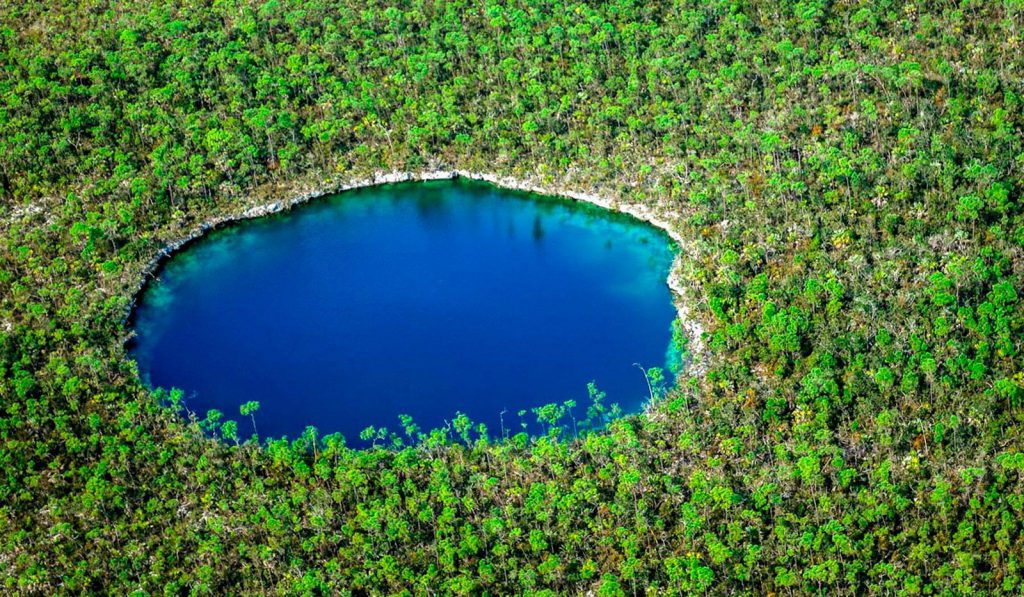Content
- 1 Introduction to Blue Holes National Park
- 2 History and Formation of the Blue Holes
- 3 Characteristics of the Blue Holes
- 4 Biodiversity in Blue Holes National Park
- 5 Tourist Activities in Blue Holes National Park
- 6 Conservation and Biodiversity Threats in the Park
- 7 The Role of Blue Holes National Park in Scientific Research
- 8 How to Get There and Where to Stay
- 9 Photo Gallery
Embark on a thrilling journey through the mysterious and dazzling Blue Holes National Park, a unique natural treasure within the Bahamas National Parks network. This park, home to some of the deepest and most astounding blue holes in the world, offers its visitors an unparalleled travel experience, brimming with natural beauty, impressive biodiversity, and endless adventure opportunities.
Introduction to Blue Holes National Park
Location and General Information
Located on the island of Andros, Blue Holes National Park is one of the most important natural spaces in the Bahamas. This park encompasses an extensive area of terrestrial and marine habitats, characterized by the presence of the blue holes, fascinating underwater geological formations. Its coordinates are 24° 47′ 22.56″ N, 77° 56′ 41.28″ W.
The designation as a National Park was in the year 2002, covering an area of about 40,000 acres. It is relatively new, considering the age of other protected areas in neighboring countries.
Importance of Blue Holes National Park
Blue Holes National Park not only houses the largest concentration of blue holes in the world but is also a critical ecosystem for a great variety of endemic species. Additionally, the blue holes are an invaluable source of knowledge for scientists, providing clues about Earth’s climatic history and the evolution of life.
History and Formation of the Blue Holes
Geological Formation Process
The blue holes, or "agujeros azules" in Spanish, are the product of thousands of years of chemical and physical erosion. Over time, freshwater and saltwater eroded the limestone substrate, creating these impressive underwater sinkholes.
Discovery and Historical Research
Discovered by the early inhabitants of the Bahamas, the Lucayans, these blue holes have captivated explorers, divers, and scientists alike. In recent decades, they have been the subject of numerous scientific expeditions, leading to the discovery of an incredibly extensive and biodiverse network of underwater caves.
Characteristics of the Blue Holes
Depth and Morphology
The blue holes in this park are famous for their abysmal depths, some exceeding 300 meters. Moreover, each one presents a unique morphology with underwater passages and spacious chambers, offering divers an unparalleled underwater experience.
Water Conditions: Salinity, Temperature, and Transparency
The water in the blue holes is renowned for its incredible clarity and shades of blue. The unique salinity and temperature conditions of these bodies of water create an environment that harbors a unique and rich biodiversity, in addition to providing exceptional diving conditions.
Biodiversity in Blue Holes National Park
Marine Species
The park is home to a rich variety of marine life, including tropical fish, corals, and sponges. Furthermore, the darkness and depth of the blue holes provide a habitat for deep-sea species rarely seen in shallow waters.
Terrestrial Species
Beyond its impressive waters, the park also houses remarkable terrestrial biodiversity. From birds to reptiles and a wide variety of tropical plants, visitors can enjoy the pristine fauna and flora of the Caribbean.
Endemic Species
Perhaps most impressive of all is the presence of several endemic species, found nowhere else in the world. These include certain types of shrimp and crabs adapted to the unique conditions of the blue holes.
Tourist Activities in Blue Holes National Park
Diving and Snorkeling
Thanks to the water visibility and rich biodiversity, the park is a favorite destination for diving and snorkeling enthusiasts. Various tour operators offer guided excursions, ensuring a safe and enriching experience.
Hiking and Bird Watching
For those who prefer to stay on solid ground, several hiking trails are available. These routes offer the opportunity to closely observe the park’s terrestrial wildlife and enjoy its breathtaking views.
Visitor Safety and Environmental Guidelines
To ensure visitor safety and park conservation, there are a series of rules that must be followed. These include limitations on diving areas, the prohibition of touching or disturbing wildlife, and the need to minimize environmental impact.
Conservation and Biodiversity Threats in the Park
Current Conservation Measures
Various conservation measures have been implemented to protect the delicate ecosystem of Blue Holes. These include limiting the number of visitors, prohibiting certain activities, and ongoing research to better understand how to preserve this unique place.
Threats and Future Challenges
Despite these measures, the park faces several threats, including climate change, pollution, and irresponsible tourism. The future challenge will be to balance the need for conservation with the desire to allow people to experience the beauty of this unique place.
The Role of Blue Holes National Park in Scientific Research
Current Research
The park is an important center for scientific research, with ongoing studies on its unique geology, diverse biodiversity, and records of past climate changes. These studies are vital for understanding our planet and how to protect its future.
Important Discoveries
Over the years, research in the park has led to several significant discoveries. These include new species, invaluable climate records, and a deeper understanding of how these fascinating geological phenomena were formed.
How to Get There and Where to Stay
Getting to Blue Holes National Park
There are several ways to get to Blue Holes National Park. International flights arrive on the island of Andros from various major cities. Once on the island, you can reach the park by car or through an organized tour.
Accommodation and Services Nearby
There is a variety of accommodation options near the park, ranging from luxury hotels to more modest lodgings. Many of these accommodations offer additional services such as park tours, scuba diving equipment rentals, and meals.
